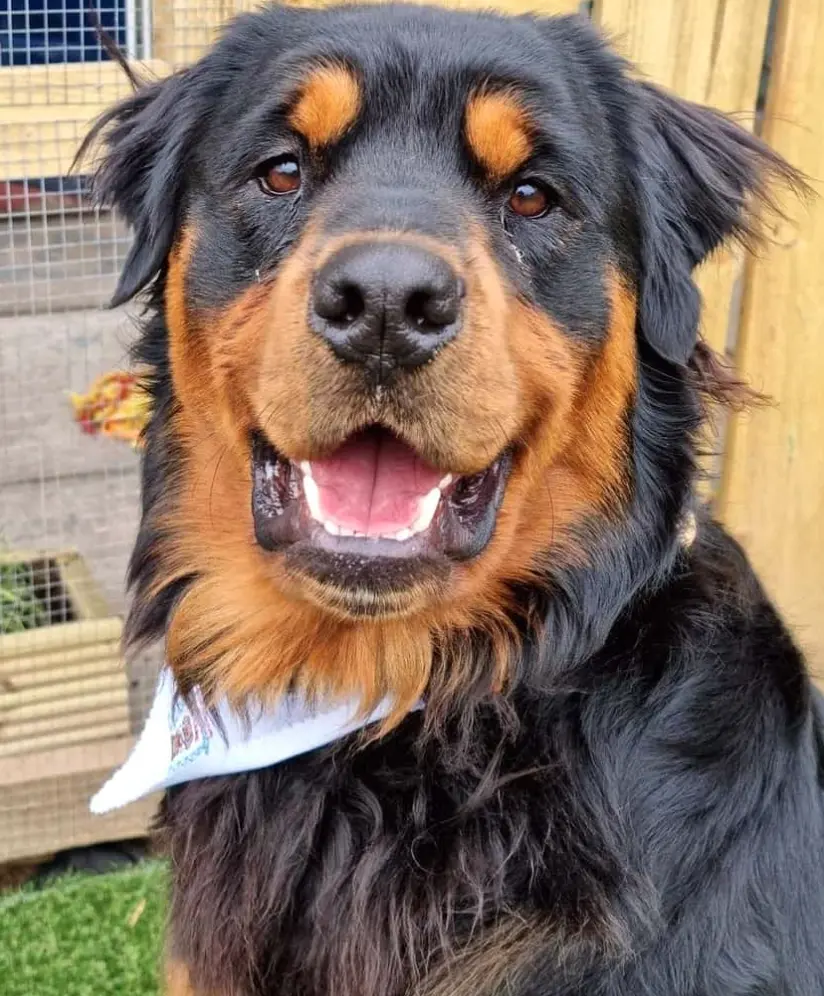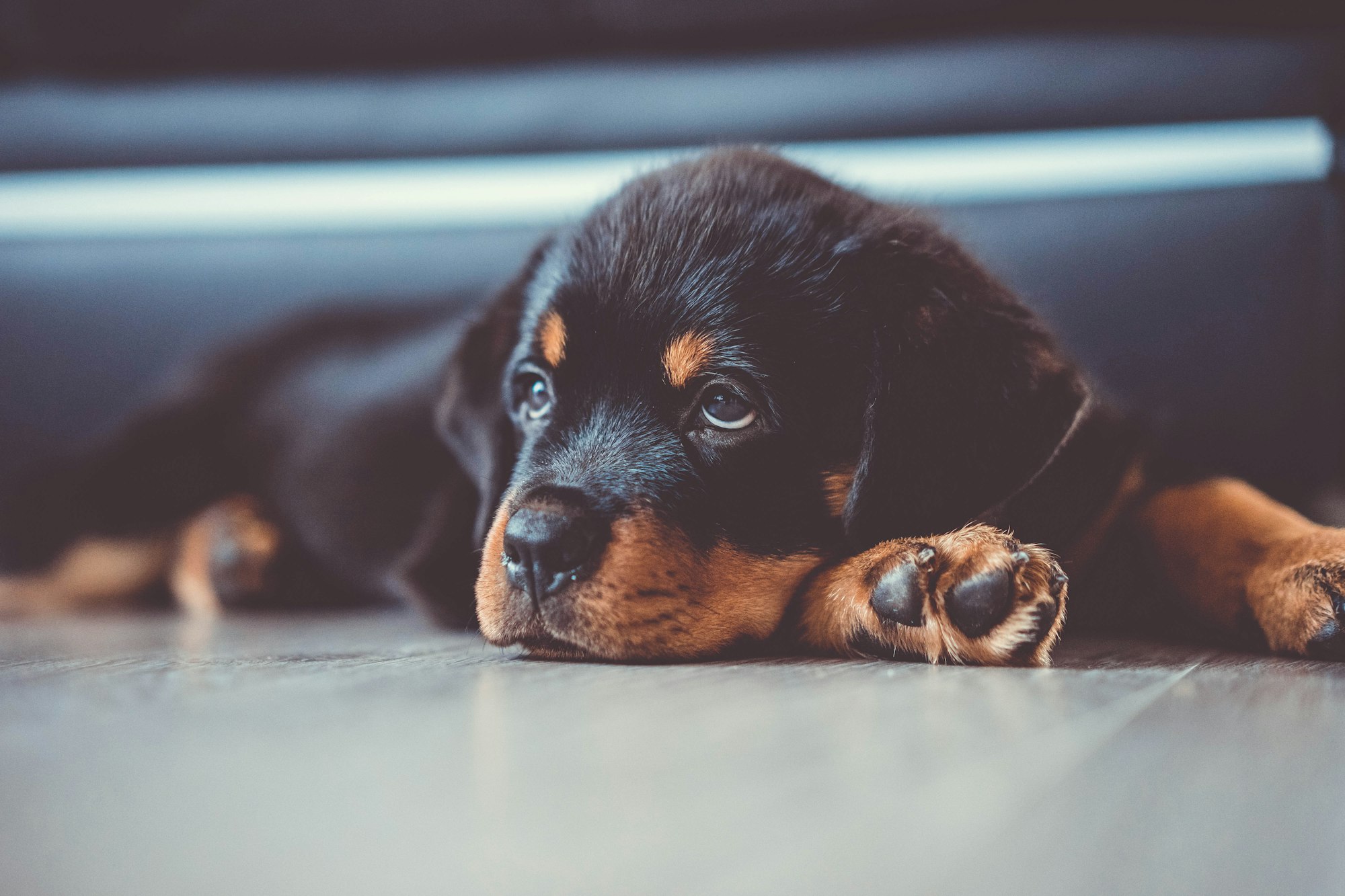Most people are only familiar with standard short-haired Rottweilers. They typically assume that a long haired Rottweiler is not an actual breed when they see it, mainly due to the limited number of these dogs.
This article will take you through some critical aspects of a long-haired Rottie, including its breed history, size, health concerns, and how to care for it.

The Long-Haired Rottweiler
It is typical for Rottweiler dogs to have hairy puppies, born with long or rough hair, which rarely result from breeding one breed of dog with another. They frequently descend from just one pure breed
The long-haired Rottweiler dog breed is a large, powerful, muscular working dog. It is believed to be the offspring of dogs that served in the vast Roman armies. It is sometimes referred to as the first military and police dog due to its excellent performance in its duties.
Initially, the Rottweiler was bred to herd and defend cattle, and contemporary examples still exhibit these traits. Rottweilers don't behave like other dogs, which only bark to alert their owners to events. Instead, if it notices an outsider approaching its owner's home, it will leap on him to chase him away.
But this only happens if the Rottweiler doesn't like the guest or if the stranger tries to act up toward the dog's owner. While Rottweilers prefer to wait and observe before engaging in combat, additionally, they require a lot of exercise and activities due to their high activity level as dogs.
Why Is A Long-Haired Rottweiler Rare?
Typically, a long-haired Rottweiler is a rare dog breed. Although uncommon, long-haired Rottweilers exist in the US due to the American Kennel Club's breeding regulations. The AKC forbids the breed due to its involvement in illicit activities like dog fighting.
The second reason for the breed's rarity is neutering and spaying. During spaying, the ovaries or uterus of a female dog are removed. Neutering refers to removing the testicles of a male dog. It also stops the dogs from having too many puppies, which lowers the risk of some cancers.

Long-haired Rottweiler Breed History
People erroneously believe that Rottweilers are among the oldest and most challenging dog breeds. The breed is said to have existed throughout the Great Roman Empire.
Romans brought their animals and drover dogs to Germany after they conquered and settled there to support their way of life. However, the Romans gave up on selling livestock and turned to farming when they realized how lush and fruitful the soil was in Germany.
When these Roman drover dogs were crossed with regional breeds, numerous new breeds were created. A new settlement was made by the Romans in southern Germany a few hundred years later.
This city developed into a booming market region over several decades, and residents from other towns began bringing their cattle and meat to sell. Molossus dogs assisted in transporting cattle to Rottweil.
However, as soon as traders began employing rail freight, the value of these dogs decreased. Luckily, they continued to crossbreed, giving rise to guard dogs, watchdogs, and drought dogs. In 1901, the first Rottweiler dog club was established to help preserve the breed.
Numerous different Rottweiler breed organizations were created to advance and better this dog breed due to folks realizing how significant they were. The Allgemeiner Deutscher Rottweiler Klub, founded in 1921, was the most well-known of these organizations.

Long-Haired Rottweiler Size
Due to their thick, fluffy coats, long-haired Rottweilers appear larger than their short-haired counterparts. They are the same height and weight as other Rottweilers under all that hair.
Typically, long-haired male Rottweilers stand 24 to 28 inches tall and weigh 115 to 135 pounds. Consequently, female Rottweilers with long hair stand 22 to 26 inches tall and weigh 85 to 115 pounds.
Long-Haired Rottweiler's Health Issues
A long-haired Rottweiler is an uncommon dog breed. However, despite having particular medical conditions or genetic abnormalities, it still contracts the illnesses that most Rottweilers do. As a pet owner, you must understand that Rottweilers frequently get sick.
Purchasing a puppy from a reputable, registered breeder with documentation proving that the dogs are free of hereditary illnesses is the easiest way to avoid Rottweiler health issues. If you choose to adopt, make careful to get all the medical information you can from the rescue organization. Below are some of the most frequent long-haired Rottweiler health issues:
- Cancer: Long-haired Rottweilers are more susceptible to developing cancer as they mature. This can be treated through chemotherapy and surgery if discovered early enough.
- Entropion: This is the sliding inward of the eyelid. It hurts because the eyelashes rub against the eyeball's surface. In extreme cases, entropion can lead to a corneal ulcer.
- Ectropion: The disorder causes the eyelid to slide outward. It causes dryness and discomfort, which irritates the eyeball and conjunctiva.
- Heart disease: Unusual heart rhythms and murmurs indicate the possibility of heart disease in a long-haired Rottweiler. An X-ray, an ECG, or echocardiography is the best approach to diagnosing the issue.
- Diabetes mellitus: Most long-haired Rottweilers are afflicted by the condition known as diabetes mellitus. A dog suffering from such a condition eats and drinks more, urinates more frequently, and loses weight as it cannot eliminate blood sugar.
- Dental diseases: Dental disease affects most long-haired Rottweilers. In the worst situations, it results in the formation of tartar on the teeth, gum and root infections, tooth loss, and kidney damage.
- Diseases and illnesses: The long-haired Rottweiler is susceptible to bacterial and viral infections like rabies, parvo, and distemper. Age-appropriate vaccinations can help prevent it from contracting a virus.
- Obesity: Overweight Rottweilers get pretty sick. Excessive weight gain can result in heart disease, digestive issues, back and joint pain, and even heart attacks. Ensure your pup eats healthily and frequently exercises to prevent it from contracting this lifestyle disease.
- Cataract and PRA: It is challenging to see when a Rottie suffers cataracts. In the long run, this will result in complete blindness. However, cataracts are treatable and reversible with surgery. Progressive retinal atrophy (PRA) may also affect the pups' eyes, resulting in blindness in its worst form. The Rottie won't have hazy eyesight as a result.
How To Care For A Long-Haired Rottweiler
You should know a few things before taking a long-haired Rottweiler home, even though owning one isn't all that different from owning any other dog breed. The most crucial actions you must take to take care of your Rottie include the following:
The Diet
A long-haired Rottweiler consumes more food than most other dog breeds due to its size. On average, it will drink 6 cups of premium dry kibble daily. You should budget $75 to $125 per month for dog food to nourish your dog's needs. Of course, you can supplement their diet with high-quality snacks, but do what is necessary.

The Exercise
The long-haired Rottweiler is a powerful and energetic canine breed. Therefore, you must engage it in enjoyable and active pursuits, like taking walks and playing fetch, for at least two hours daily. The breed requires extra activity; thus, it should have a fenced-in yard.
A fenced-in yard, however, is different from taking walks. Instead of just putting the pup outside and expecting it to run around, you should still take it out every day for about an hour and play with it in the yard.
Grooming
Although a long-haired Rottie is a lovely dog, it requires extra grooming due to its long fur. The dog sheds, although not as much as other breeds do. It is best to brush your Rottie a few times a week to prevent its hair from getting tangled and manage how much it sheds.
Besides, it would help to brush the dog's teeth a few times a week to keep its mouth clean. Even though your long-haired Rottweiler may not initially enjoy it, maintaining its teeth over time will help you save a ton of money.
Keep The Coat Dry
A Rottweiler's thick coat is dense and water-resistant. Ensure your Rottweiler is dry if it has been in the rain or the water. A damp dog has a foul odor and is fertile ground for germs. If your Rottweiler enjoys using a hairdryer, keep the nose away from your dog's skin and use the coolest setting possible.

Final Thoughts
A long-haired Rottweiler is a perfect family dog if you're confident you can train one. Although it is more expensive and rarer than the standard short-haired version, you'll understand why the breed is so favored once you meet one.
Before bringing a puppy home, ensure you have everything you need to care for, because it won't remain so small for long. Our Fi Collar will definitely come in handy to keep your Rottie within sight.
Visit the Off Leash blog at TryFi.com for more helpful articles about pet-parenting tips.
Would you like to learn more about TryFi.com? The Fi Dog Collar is a GPS tracking collar that not only tracks your dog's location, activity level, and sleep pattern, but also alerts you if your dog escapes. If your dog escapes, this is the fastest way to find him. Give the Fi Dog Collar a try today!

